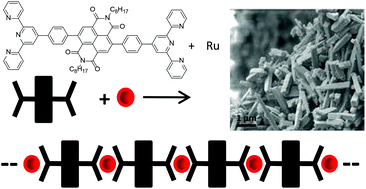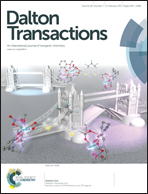Core substituted naphthalene diimide – metallo bisterpyridine supramolecular polymers: synthesis, photophysics and morphology†
Abstract
A series of metallo Ru(II), Fe(II), Co(II) bisterpyridine polymers were prepared with naphthalene diimide (NDI) groups inserted between two 4′-phenyl-2,2:6′,2′′-terpyridine (phtpy) groups. Core-substituted NDIs typically have long-lived excited states with relatively high quantum yields, yet the NDI emission in these metallopolymers was completely quenched, most likely because of efficient electron-transfer from the M(phtpy)22+ groups to the excited NDIs. AFM, TEM and SEM experiments indicate that the regiochemistry of the substitution on the core of the naphthalene diimide, together with coordination of the terpyridine ligand to different metals, strongly influences the morphologies of the resulting metallosupramolecular polymers. The morphologies of spin-coated samples of the para-substituted polymers revealed the formation of long, bundled nanorods. Lengths on the order of ∼8 μm were observed for the bundle of the longest polymers (5-Ru) by both AFM and TEM microscopy. The morphologies of the meta substituted polymers, on the other hand, exhibited significantly shorter and less well-defined morphologies.


 Please wait while we load your content...
Please wait while we load your content...